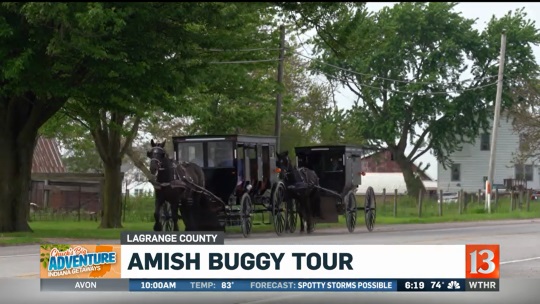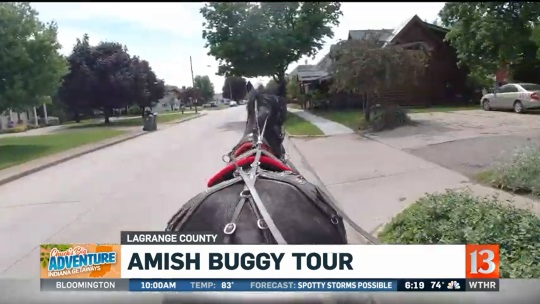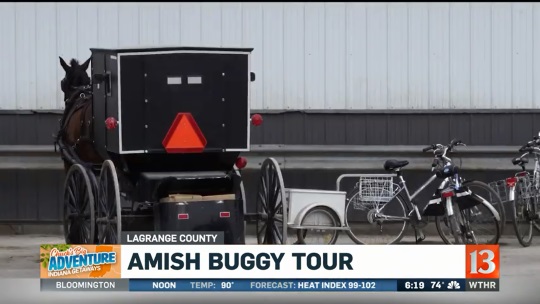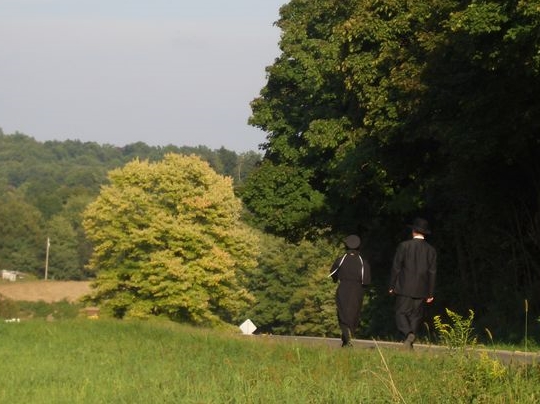5 Insights From Indiana Amishman John Gingerich
Are the Amish “backward”? Do they miss modern things we take for granted? What’s the correct way to pronounce “Amish”?
Chuck Lofton of news station WTHR recently rode along with John Gingerich, an Amishman who operates a tour buggy in Shipshewana in northern Indiana.

John shared several interesting insights as they rode around town. He seems like the kind of guy you’d want running your buggy tour – knowledgeable and with a sense of humor.
Part of the interview is available in the accompanying article, and part of it is in the video clip shared below. Here are five insights from John, with some comments from me.
5 Insights on the Amish from John Gingerich
1. Amish live better than we might think – Though outsiders might see them as backward, the Amish (and especially those in more progressive communities like northern Indiana) have a lot of modern amenities – indoor plumbing, modern bathrooms, etc.
The electricity is the main thing that’s missing. But even this comes with a caveat – batteries power some electrical needs, though crucially the Amish remain off the public grid. “Without electricity, without cars, we still live very well,” says John.

2. People don’t know how to pronounce “Amish” – John says that a lot of people come to see the “A”-mish (pronounced with a long A). But he, as he notes with a smile, is something else – Amish (“Ah”-mish). Jokes aside, he doesn’t mind that people come with a funny pronunciation.
3. If you’ve never had something, you don’t miss it – Well put. People sometimes seem to feel sorry for the Amish in that they must be suffering and missing out on all the trappings of life that non-Amish enjoy. But if you grow up a certain way, that way is “the norm”.
It doesn’t mean that some Amish-raised people don’t crave for an automobile or continued education. It’s just that when we imagine the Amish must miss x or y, what we’re really doing is placing ourselves in an imagined Amish existence, and saying “boy if I was Amish, I’d really miss x and y.”

The other side of this coin appears when outsiders attempt to join the Amish. If you’re not raised in the faith, it can be difficult to adapt, and more importantly, remain in the church. And that’s not just about becoming accustomed to the material differences, but things like the mentality and the individual/community dynamic which are fundamental to the Amish church.
4. People have the wrong idea about Rumspringa – I liked what John says in response to the idea that it is okay with Amish parents if their teens “go out in the world and experience whatever you want to do and see if that is what you want to be for the rest of your life.” John’s retort?
“That’s a complete falsehood. Why would we do that? We try to teach our children our way so they will follow our ways. Why would we do that? It would be like putting the fox in charge of guarding the hen house. Not at all. And I tell people that because a lot of people are under that impression. I tell them spread the word for me.”

We’ll try to do our small part here, John.
5. John was OK with an on-camera interview – because he appeared in a video, not a still shot – John justified this by saying that they are moving images, and won’t be put up on a wall.
I had never heard an Amish person offer this reasoning, as to why video was ok over still photos (usually, you’d think, a simple photo would be more acceptable than an interview, which is essentially capturing thousands of images in sequence).
Watch the interview in full below:






informative
The video, in particular, is the kind of educational tool I would use for the” introduction” to an introductory lecture about the Amish for a sociology class at a university. There is no reality show you-know-what in it, and the news anchors likewise did not over-generalize or over-react.
Joe, sounds like John would even be a good, and quite possibly willing, guest speaker in one of your courses. I guess he’s a little far from you, but I wonder, since it seems he is not against appearing in video, if he would be open to doing a fuller-length educational interview that could cover a lot of the Amish 101 topics, that you could then show in your class? Just thinking out loud here 😀
Refreshing Amish Interview
My deep respect for the Amish way of life was enhanced by the interview with John Gingerich. He was friendly, open and honest and increased my respect for his way of life. It has encouraged me to want to visit Shipshewana, Indiana and learn to appreciate more of the Amish culture. GD
Glad you liked it Gary. I was happy to come across this, and glad to know that community has someone like John doing that service for the public.
John Gingerich seems like an interesting person to talk with and I think I’d enjoy visiting with him next time I’m in Shipshewana.
As I read this posting and the article linked to it and viewed the video, I wondered if Chuck Lofton realizes that there are differences in Amish lifestyle right in the Elkhart-Lagrange settlement which Shipshewana is part of. If he traveled to some of the more rural parts of the settlement northwest or east of Shipshewana he would find Amish people dressing plainer and using less technology than the Amish use in Shipshewana. I would encourage him and anyone who enjoys visiting Shipshewana because of Amish culture to visit Menno-Hof Amish-Mennonite Information Center at 510 S. Van Buren St. in Shipshewana. There a person learns much about Amish history and some of the religious reasons out of which flow Amish life today.
Good that you mention that Al. I’m not sure that he does, but I enjoyed how he seemed genuinely thrilled at the opportunity to do the interview. I don’t think it’s as rare as they make it sound, but it is true that it is not common to get an Amish person on camera like that. You know I’ve never been to Menno-Hof despite spending 4-5 months total in that community. I think you’ve recommended it before here, so I’ll need to at least drop in next time. Would you say it is similar to the Amish and Mennonite Heritage Center in Berlin, OH?
In response to your question regarding Menno-Hof, Erik —
I’ve been to the Mennonite Heritage Center/Behalt several times and have learned more each time. I especially appreciate the library at the center and found the staff very helpful in answering questions and directing me to resources in the library to learn more about Amish history and life.
Menno-Hof in Shipshewana tells the same story as the Mennonite Heritage Center but in a different manner. Menno-Hof tells the Amish-Mennonite story through several multi-media presentations, displays and “historical environments” such as the Dungeon ( persecution of the early Anabaptists), Meeting House ( Amish and Mennonite worship, and Amish room (sample of a kitchen and living room in an Amish home).
A person can learn much about Amish history, etc., from 1525 up until the present time and can stay as long as they wish — even come back the next day to learn more at no extra charge! A virtual tour is available on the Menno-Hof website at mennohof.org
Menno-Hof was largely the vision of a Mennonite minister in the area in the 1980’s who desired that the thousands of visitors to the area each year needed an opportunity right there in Shipshewans to learn that there is much more to Amish life than quilts, auctions and good food. Currently the board of directors, staff and volunteer tour guides are from a variety of Anabaptist groups — Mennonite, Amish, Beachy Amish, etc. It is great to see how they all are cooperating together to tell the Amish-Mennonite story.
Thanks for your answer, Al. I wasn’t aware of the format, that does sound like an interesting immersive way to do it. Need to check it out.
Progressive
Erik,
As usual such insight you provide to the many “different” Amish; thank you.
As per the extreme conservatives, the buggy John Gingerich is driving would be considered anathema – too fancy and prideful. The color would be an exception as well as the bridal wear – and here no one has windows and a windshield just to name a few infractions.
The conservative Amish are adamant about taking any pictures – “graven image” as per the Bible. This is one of the issues they will confront the English about, and post signs by their farm stands “please do not take pictures”. In addition the “graven image” is the reason for faceless dolls among the conservative Amish.
Nevertheless, the ultra conservative Amish here would agree with Gingrich – despite no indoor plumbing, the use of outhouses, as well as a limited consumption of propane – Amish feel they live very well indeed!
Chariot buggy:)
Good that you pointed that out Maureen – the buggy struck me as odd too, I expected it to look something like the tour buggy we see in the opening shots of the report – oversized, but still Amish-style. This one looked more like a royal chariot.
Maybe John was driving the “premium package” buggy that day? 😀 Anyway I found that amusing.
Chariot buggy
Very amusing, indeed!
John, I'd like to know your thoughts...
I have noted a difference in rumspringa between the lancaster community and those I’ve met in the midwest. In lancaster rumspringa seems to focus on socializing, dating, finding a mate and then settling down to live in church. Elsewhere it seems the focus seems to be on joining the church or not. How do you see this?